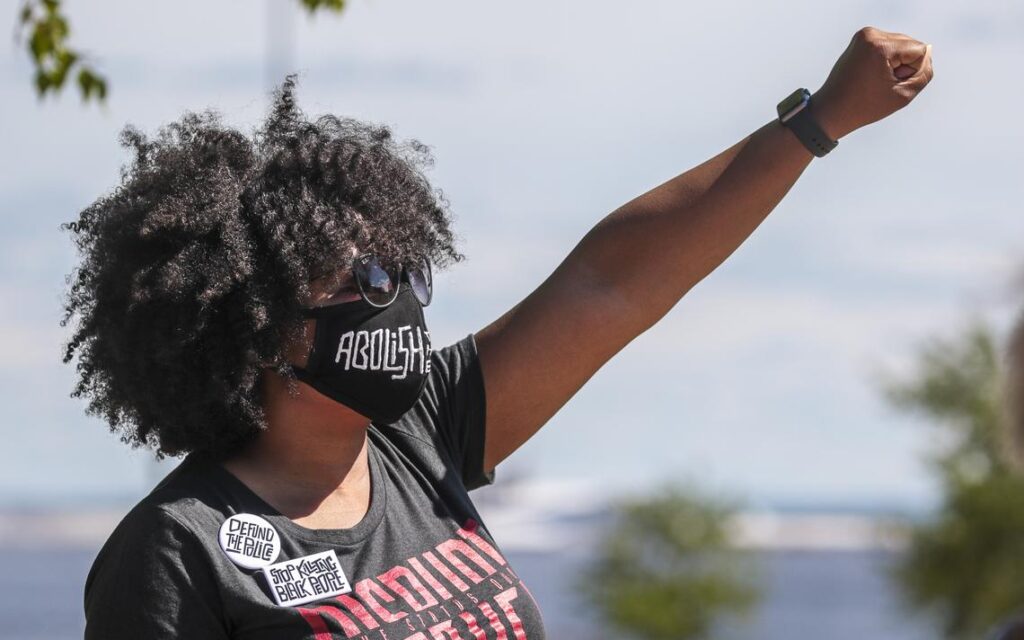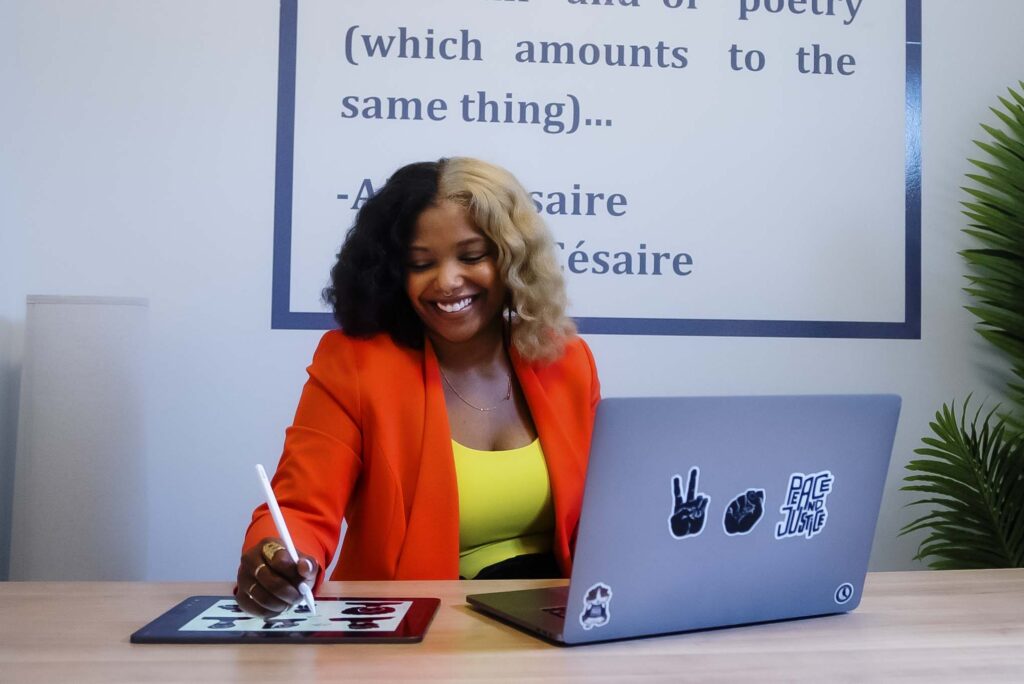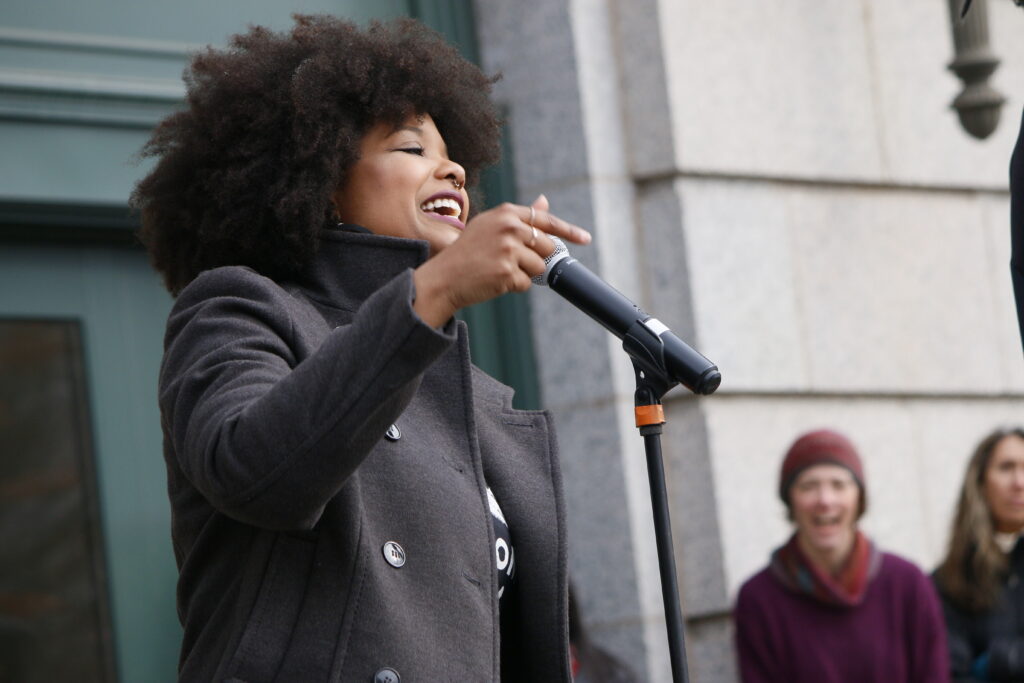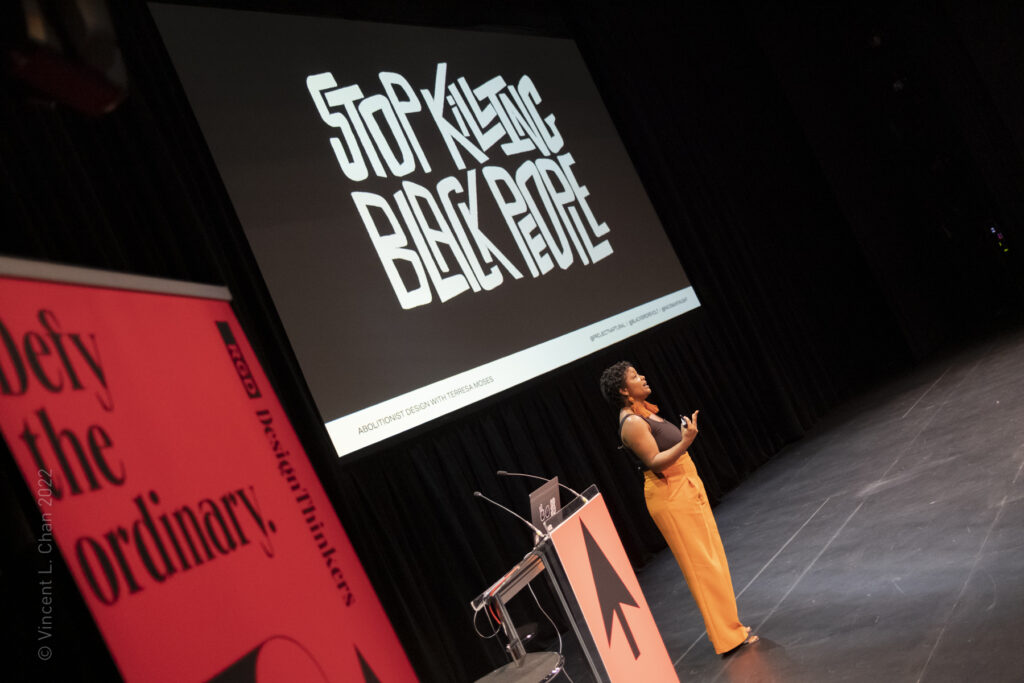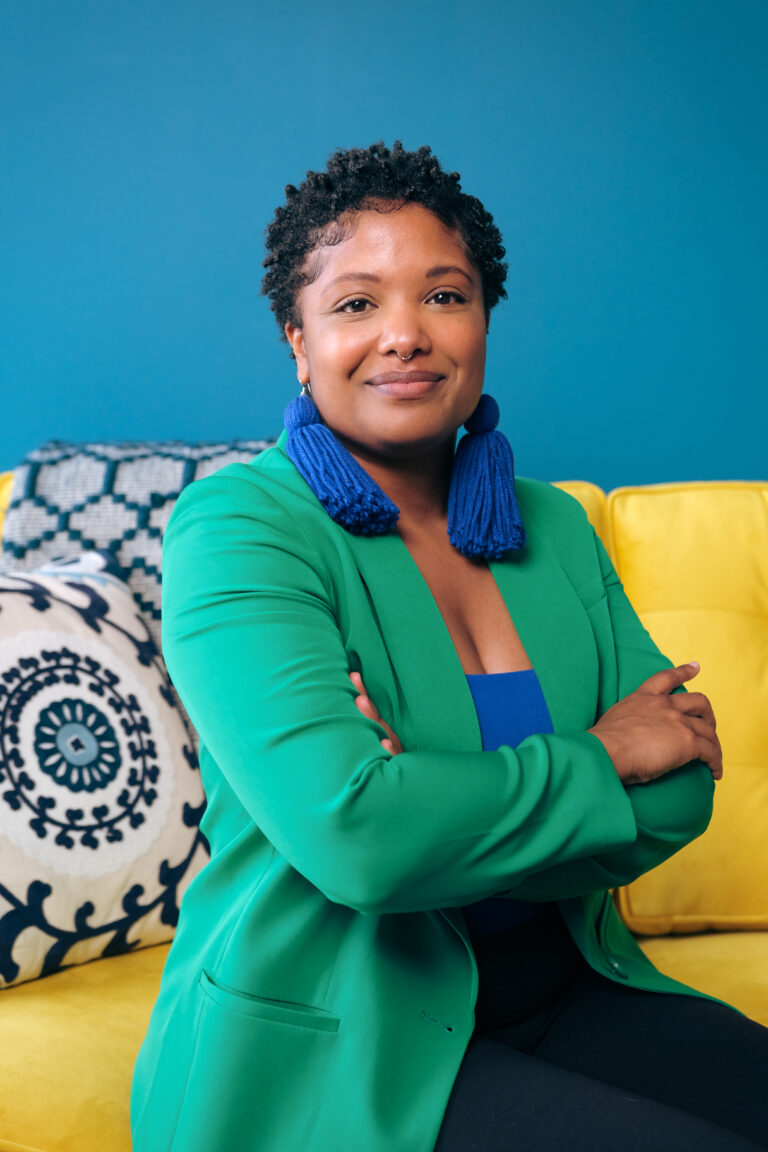
About Me
Hello, I’m Terresa; an abolitionist, design researcher, author, anti-racist facilitator, creative director, organizer, and educator based in Minneapolis.
I am a proud Black queer woman dedicated to the liberation of Black and brown communities through art and design. As a designer and illustrator, my work focuses primarily on race, identity, and social justice. I advocate for positive change in my community using creativity as tools of community activism and organizing like my solo intersectional exhibition, Umbra, and my community distro project, Stop Killing Black People. I intentionally create spaces and support initiatives in which members of the academic and broader community might challenge their own positionality in the context of oppression and understand through a cross-disciplinary lens how their personal experiences and biases affect their outcomes.
My work supports and is inspired by racial activist movements. I use design and illustration to communicate messaging that activates community and inspires positive change. My passion for design and racial justice has provided me with the opportunity to be a part of creative and innovative brands, projects, and campaigns from print, film, and interaction design. As the Creative Director of Blackbird Revolt— a social justice-based design studio— I use design innovation to further Black liberatory and abolitionist efforts. Because of the identities I hold and my scholarship within areas of identity, I am compelled to support projects which validate and uncover systemic and institutional racism through my creative work.
In continuing my anti-racist work within the academy, I am an Assistant Professor of Graphic Design and the Director of Design Justice at the University of Minnesota’s College of Design. I earned my Bachelor of Fine Arts in Fashion Design and African American Studies and my Master of Fine Arts in Design Research and Anthropology from the University of North Texas. As a life-long learner, I am now pursuing my Doctorate of Philosophy in Social Justice Education at the University of Toronto exploring how the movement for Black lives in Minneapolis might influence the curricular foundation of graphic design education. With Black liberation as a core mission in my academic work, the courses I create and teach engage students in anti-racism and anti-oppressive frameworks. As a community engaged scholar, my design research interests include; Project Naptural — which creates spaces to educate, connect, and empower Black women about their natural hair and self-identity— and Racism Untaught— a curriculum model that reveals ‘racialized’ design and helps students, educators, and organizations create anti-racist design approaches through the design research process. I have multiple publications including two books set to publish in October 2023 through MIT Press, Racism Untaught and An Anthology of Blackness.
I currently serve historically underrepresented and underinvested communities by planning Black liberatory protests, drafting abolitionist policy, and using design as a tool for mass communication and movement unification. I am currently a community partner and collaborator with Black Liberation Lab— an organization which co-creates solutions to support Black liberation.
Previously, I served on the executive committee of the Duluth NAACP as the 2nd Vice President, Young Adult Committee Chair, and Charter Advisor to the UMD NAACP Chapter. I also served on the board of the Clayton Jackson McGhie Memorial, on the board of AIGA Minnesota as the Director of Diversity & Inclusion, and as a core team member of the African American Graphic Designers.
My research, scholarship, and creative work intentionally intersect three areas of expertise, all of which are centered in anti-racism and Black liberation: 1) design curriculum and pedagogical approaches, 2) community building and abolitionist organizing, and 3) empowering Black women. As a design researcher and community-engaged scholar, I use theories and research methodologies to identify and create design approaches to real world problems based in anti-oppression in the areas of race, gender, and anti-violence.
In regard to curriculum and pedagogy, I am currently working on a project with Lisa Mercer called Racism Untaught which looks at the how design professors utilize design research to critically assess anti-racist concepts and solve racialized design problems within project-based learning environments. We are using both quantitative and qualitative research methods and theories to create a toolkit that faculty, students , and organizations can use to solve racialized design challenges. We have iteratively improved upon the toolkit through working with our industry partners including Target, Spotify, Shopify, PayPal, Matterport, and Apple; and our academic partners include the University of Minnesota, University of Illinois, Parsons School of Design, Louisiana State University, Auburn University, the University of Cincinnati, University of Tennessee Knoxville, the School of Visual Arts New York, and the Interior Design Educators Council. Our progress in the creation of this framework and toolkit is documented in Racism Untaught: Revealing and Unlearning Racialized Design with MIT Press to be published in the Fall of 2023.
In addition to anti-racism, I am deeply passionate about Black liberatory-based curriculum. I am currently using my dissertation as a time to look specifically at how the movement for Black lives has and should affect graphic design education. Specifically: How has and should the movement for Black lives impact design education and provide opportunities to create design curriculum and pedagogical approaches centered in the liberation of Black communities in the United States? My intended outcome is a collection of curriculum that can be used in design programs across the country that not only teaches foundational design principles, but teaches them from a pro-Black and Black liberatory lens. In addition to my dissertation, I collaborated with Omari Souza to co-edit a book which centers Blackness and the Black experience in industry and organizations, pedagogy, and activism. An Anthology of Blackness: The State of Black Design is set to be published in the Fall of 2023.
Secondly, I use modern qualitative methods to inform design decisions in my efforts to build community and organize toward progressive and abolitionist policy and practice change. My creative activity intersects various ethnographic research methods to create opportunities for systemic equity on a local level. This past year has brought about the opportunity to disseminate unifying messaging around the movement for Black lives within the Twin Cities area. After the murder of Daunte Wright, I organized to raise over $30K in funds to print messaging such as “Stop Killing Black People,” “Abolish the Police,” “All Power to the People,” “Justice for Wright,” “Black Lives Matter,” and “People Over Property.” This award-winning typography is worn and held in signs by abolitionist protestors across the Twin Cities.
My work with my design studio, Blackbird Revolt, centers Black liberation and abolition in the projects we create and the partners we work with. This industry experience helps guide my creative outputs and benefits students through my industry connections. Through my studio, I’ve created award winning work that has ranged from exhibitions to rebranding/creating campaigns for initiatives around diversity, inclusion, equity, and accessibility. I have been a part of liberation-centered projects— from print, film, and interaction design— with organizations such as MPR, The Nature Conservancy, Futures Without Violence, United Way Twin Cities, Water 1st Foundation, Minnesota Department of Human Rights, Minnesota Department of Parks and Recreation, Maji ya Chai Land Sanctuary, More Than a Verdict, Sankofa Impact, NAACP Duluth, Clayton Jackson McGhie Memorial, Minnesota Historical Society, Family Freedom Center, Pollen Midwest, The College of Saint Scholastica’s Office of Equity, and the University of Minnesota.
Lastly, my scholarship and creative work centers the life experiences of Black women. I use methods and theories such as auto-ethnography, counter-storytelling, and emancipatory research to create spaces and craft information that centers Black women. In my latest solo exhibition— Umbra— does just that, focuses specifically on the intersectional experience of the oppression of Black women. I was compelled to create this work to validate and uncover the institutional racism and sexism perpetuated everyday and how those actions affect Black women with six themes including: Gaze, Control, Savior, (D)Anger, Burden, and Liberation. Each theme includes two illustrative pieces as well as a tactile creation to help viewers understand the experience more clearly.
In addition to Umbra, another example of scholarship that I am invested in to empower Black women is Project Naptural (nappy+natural). Project Naptural is an applied research project that aspires to influence decision making about natural hair within the Black community by disseminating information about hair cultural practices and providing opportunities for intergenerational connection. This socio-cultural initiative is designed to initiate and sustain positive change in how and why many Black women form and frame perceptions about their identities— due to white Euro-centric norms of beauty— by choosing to wear their hair in its naturally afro-textured state. I use communication design, exhibitions, and symposiums to enlighten, connect, and empower Black women to make informed and healthy life choices in regard to their hair.
Much like my scholarship and creative work, my teaching philosophy is centered in abolitionist and Black liberatory principals. I use the teachings of bell hooks, adrienne maree brown, Angela Davis, Audre Lorde, among many other brilliant Black feminist thought leaders to guide how— my pedagogical approach— and what— my developed curriculum— I teach.
In regard to my pedagogical approach, I am intentional at creating space in which students and other participants feel welcome to challenge their own thinking and understand how their positionality, personal experiences, and biases affect their work. I accomplish this with the use of a collective agreement surrounding the classroom culture which I develop with students during the first week of any class. I also use the first week of the course to have intentional time for introspection through daily check-ins, self assessments, photo collages, and even poetry. These assessments which students present to their class helps in establishing a mutual understanding and genuine interest in the students’ life which brings a level of comfort and vulnerability in the classroom that allows the student to learn from mistakes, pose viable questions, and create numerous learning opportunities. Through intentional pedagogical approaches such as the ones above, I believe it shifts social power in the classroom, empowering students in ways that allow them to make their own choices, not only regarding design, but in their own lives. The knowledge I pass along is purposefully applicable throughout all facets of life, while simultaneously creating an eagerness to learn more.
I value the students’ future contribution in making our world a better place. It is because of this inevitable contribution and heavily-weighted responsibility they will soon carry, that I am unafraid of talking about issues of race, gender, sexuality, ability, and other forms of identity that can marginalize our communities. These topics, while uncomfortable, are necessary when I look forward to a time in which these same students will be crafting policy and normalizing practices that can further oppress or liberate our communities.
In regard to the curriculum I develop to teach required learning outcomes, I center my projects around anti-racism, collective liberation, social consciousness, and social impact. I accomplish this in a very direct way with projects such as: 1) The Movement Imprinted— a Black culture-inspired exhibition influenced by the work of Black designers, 2) Community Storytelling— developing illustrations and typographic layouts to tell the stories of community youth, 3) Code of Ethics— crafting and designing a living document meant to guide students to make intentional choices throughout the industry and community, and 4) Branding the Movement— creating a branded social movement helps bring awareness, calls individuals to action, and positively/progressively impacts our communities. These projects I’ve developed create intersecting opportunities to design towards a future that supports collective liberation. These projects also support my ideology that the student’s learning environment lives and evolves inside and outside of the classroom.
All of the projects and initiatives in my areas of service work towards anti-racist culture shifts and collective liberation. I intentionally align my interests with social justice or arts based organizations and initiates which further my vision of Black liberation.
I currently serve as the Director of Design Justice for the College of Design. My vision for this role in design justice centers on intentional community relationships which support anti-racism, positive culture shifts, and liberation for under-invested communities. This role has allowed my to join University representation on the Office of Equity and Diversity Leadership Council and the Social Justice Scholarship Directory. My service to the college through this role include hosting affinity spaces for BIPOC, Queer, and Allies, Pedagogy Audits, the Design Justice Faculty Cluster Hire, Design Justice Fellowship Program, and a partnership with MCAD in their Design Leadership Institute.
I am a member of AIGA –professional association for design. I am also a member of the Design Research Society (DRS)–A learned society committed to promoting and developing design research. Previously, I am served as a core team member of the African American Graphic Designers (AAGD) supporting Black designers as they become forces of change in our industry and our community.
I helped to create and organize I currently serve community by planning protests, drafting policy, and using design to communicate community issues such as abolition. I am currently a community partner and collaborator with Black Liberation Lab, who co-creates solutions to support Black liberation. I also work with Creatives After Curfew to use art to support healing and awareness on issue of Black liberation throughout the Twin Cities community.
